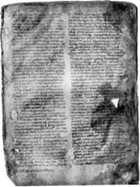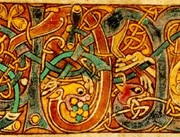 Fragment from the First Redaction Of The Book Of Invasions (Lebor Gabala Erenn): Preserved in The Book Of Leinster (c.1150) |
Lebor Gabala Erenn (Book Of Invasions)The Lebor Gabala Erenn, usually called The Book of the Invasions of Ireland, is a a "synthetic history" comprising a compilation of stories about the origins of Ireland and its people, assumed to be a blend of legends and oral history from prehistoric times. It is one of the great mythological masterpieces in the history of Irish art, testifying to the traditions of storytelling and oral history in gaelic Celtic culture. The earliest complete manuscript which survives, dates from the twelfth century CE, but evidence indicates that the original text was composed many centuries beforehand. Somewhat controversially, the twelfth century manuscript places all the myths, legends, early history, and genealogies of Irish origins within a Christian and biblical framework, starting from the Creation. |
 Example of the curvilinear style of design used in the Book of Kells, deriving from traditional Celtic art. |
|
OTHER RARE IRISH
MANUSCRIPTS HISTORY
OF CELTIC CULTURE |
According to the Lebor Gabala Erenn, Cesair (Cessair), a granddaughter of Noah, together with her father, Bíth, and her followers, are the first to reach Ireland but perish in the flood shortly after. The next invasion was led by Partholon (possibly Greek), a descendant of the biblical Magog, son of Japhet. After overcoming the Fomor (Fomorii), a race of supernatural beings, Partholon's tribe assumed control of the country for three centuries, until consumed by plague. Thirty years later, Nemed, another descendant of Magog arrived in Ireland. Allegedly from Scythia, a tribe to the North of Greece, he and his Nemedian tribe deforested many plains in Ireland and (like Partholon) defeated the Fomor in battle. Then Nemed himself along with several thousand Nemedians died from the plague, after which the remainder were ruled by and paid heavy taxes to the Fomorii. In due course the Nemedians revolted and besieged the fortress of Conann, King of the Fomor. During this Battle of Conann's Tower, the Fomor king was slain, but Nemed's son (Fergus Redside) and his Nemedian army was defeated by the Fomorii in a surprise attack. Some seven years later, the remaining Nemedians divided into two groups. One group went back to Scythia, another sailed for 'the north of the world', while the final group, led by Fergus Redside and his son Briotan remained in Ireland and the rest of the British Isles. According to the Lebor Gabala Erenn, the Britons are descended from the third group. |
|
DESIGNS OF THE ANCIENT
CELTS |
Time passes. Then the first group returned to Ireland from their homeland, escaping persecution from the Greeks. They arrived in Ireland in three cohorts known as the Fir Bolg, the Fir Domhnann and the Gaileoin. Gathering together at Uisneach in County Meath, they divided Ireland into five provinces and set up kingships. (Note: some historians associate the Gaileoin with the Laighin, the tribe from which Leinster (Laighean) is derived, and the Fir Domhnann with the Dumnonii of Cornwall and the Damnonii of Scotland. The next invaders of Ireland were a supernatural race called the Tuatha De Danann, who, in contradistinction to all other races named in the Lebor Gabála Erenn who conquered Ireland, are described in great detail. Tall, powerful, fair-skinned and red-haired, they had an aura of superiority about them, and established themselves around Bru na Boinne, the Boyne Valley, the location of Newgrange and other great megaliths from the late Stone Age. |
|
|
According to Lebor Gabala Erenn, these Tuatha De Danann were descendants of Jobhath, the third son of Nemed, who left Ireland after the Battle of Conann's Tower against the Fomorii. After spending time in Greece, during possibly the late Bronze Age or Iron Age, they then meandered across Europe settling first in Scandinavia, and then in Scotland (Alba). Determined to reclaim their rightful Irish heritage from the Fomor and the Fir Bolg, they developed four magical items to give them victory: the Stone of Destiny (Lia Fail), a throne capable of declaiming whether the king about to be crowned was indeed the proper ruler of Ireland; the Spear of Lugh, possession of which guaranteed victory; the Sword of Nuada (Cliamh Solais) which, once wielded would overcome any opponent; and the Cauldron of the Dagda, capable of feeding anyone and everyone. The Tuatha De Danann were lauded in many sources, being described as brave, handsome, intelligent, powerful, skilled in music and true men of art. In any event, they ruled Ireland until the advent of Celtic invaders known as the Gaels. The last set of invaders described by the Lebor Gabala Erenn, are the Milesians (Celts?), who took their name from Mil Easpain (soldier of Spain), whose real name was Golamh. Curiously the arrival of the Milesians from Iberia is consistent with what we know of the movements of Celts during the Iron-Age in first millennium BCE. In summary, irrespective of its historical accuracy, as a work of literature the Book of Invasions of Ireland represents an important element in the history of Irish art. The Royal Irish Academy has a seventeenth version of the Lebor Gabala Erenn. Written in Irish at the Convent of Lisgoole in Lough Erne by Micel O Cleirigh, assisted by Fearfeasa O Maolchonaire, Cucoigriche O Cleirigh, Cucoigriche O Duibhgeannain (compilers of the Annals of the Four Masters) and Maguire's own chronicler, Giolla Patraic O Luinin, it was commissioned by Brian Ruadh Meguidir (Maguire), Baron of Inniskillen. |
|
• For more about the history of Irish
culture, see: Visual Arts in Ireland. ENCYCLOPEDIA OF IRISH AND CELTIC ART |